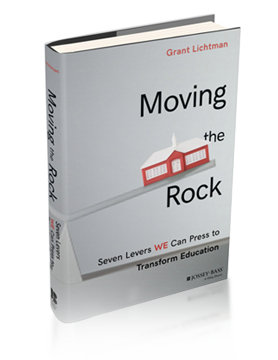“I have been teaching for 14 years”, veteran elementary teacher Dana Honner told me yesterday, “and I always thought I really knew my students as individual learners. I was totally wrong. In the few months that I have been teaching in this system of truly personalized learning, I finally actually know each of my students as an individual.”
I have visited something like 175 schools in the last seven years, so finding something new, something that really re-sets my bar of what education CAN look like is tough. But that is what happened during my day at Harrisburg School District schools just south of Sioux Falls, South Dakota. That’s right, folks on the coasts where you may think education innovation lives; you may have to get on a plane to South Dakota to see what truly personalized learning looks like, at least at the elementary and middle school levels, today.
 Harrisburg is a small town just on the south margin of Sioux Falls, but they draw students from within the larger city’s boundaries. Harrisburg is growing rapidly; there is ground under development for new housing projects everywhere and the district is adding schools every few years. There is not a lot of diversity here, so we have to keep that in mind when looking at how a system of personalized learning emerges in practice . The neighborhoods are largely white and upper middle class. With strong district leadership, they launched a personalized learning alternative program in the high schools about six years ago that ran into some headwinds. They learned the hard lesson that you can’t take kids who, for their formative years, have “rung the bell and received the treat” and expect them to suddenly own their own learning pathways at age 15.
Harrisburg is a small town just on the south margin of Sioux Falls, but they draw students from within the larger city’s boundaries. Harrisburg is growing rapidly; there is ground under development for new housing projects everywhere and the district is adding schools every few years. There is not a lot of diversity here, so we have to keep that in mind when looking at how a system of personalized learning emerges in practice . The neighborhoods are largely white and upper middle class. With strong district leadership, they launched a personalized learning alternative program in the high schools about six years ago that ran into some headwinds. They learned the hard lesson that you can’t take kids who, for their formative years, have “rung the bell and received the treat” and expect them to suddenly own their own learning pathways at age 15.
Learning from their early pilots, they have done a re-boot, starting in elementary and middle schools, and led by one of the more remarkable educators I have encountered, Travis Lape. I spent a day with Travis visiting schools at all three divisions, and what I saw was enough that I will spread it over several blog posts. But here is a universal comment: with most schools, I recommend that an inspection of their website and a video chat with some of the principles is often as good as a school visit. With schools that have largely re-booted the traditional school operating system, like Design 39 Campus, High Tech High, Mt. Vernon Presbyterian, Cajon Valley schools, or Science Leadership Academy, you need to send someone to see it in practice, period. It is just too much, and too beautiful, to try to describe in words.
With the re-boot to the lower grade levels, they now have students and their families rising through the system that understand and demand personalized learning. At most of the district schools, there are parallel tracks; families can select into either the traditional or personalized track. Not surprisingly, as families see what kids can do when they own their own learning, the personalized track is rapidly overtaking the traditional in popularity; one elementary is now 100% PL track. Here is what IS surprising: now in their third year, they have had virtually zero loss of either families or faculty from the PL track back to the traditional track
So, take a look at the Travis’ website; it has most of the information on personalized learning that is not really highlighted on the district and school site web pages. I will do my best over the next week to add from what I saw at the elementary, middle, and high school levels there.












Leave A Comment